
From the dawn of history until the late 1800s, the main project of science was to discover the logical order behind the chaos of common experience. Everyone knew the phenomena ; noöne knew the reasons. Then came radiation, and a new world.
In the Twenty-First Century, when invisible radiation is a commonplace, it is difficult to remember how astonishing, how utterly confusing, this unexpected intrusion of the literal "occult" must have seemed : unseen influences from an unseen universe, or an unseen sector. Even the "dark matter" and "dark energy" of modern astrophysics are not really comparable. Among the first and most intrepid explorers of the high-energy frontier was Wilhelm Conrad Röntgen, who died on this day in 1923. In reproducing his first report of a new continent, which Columbus-like he took for another, it is tempting to add modern notes, but I think it is better to refrain from this. These are the words of a discoverer.
Sir James Mackenzie Davidson wrote:
"While travelling on the Continent in 1896 I made a pilgrimage to Wiürzburg, and called at Professor Röntgen's house in the evening, and was kindly granted an appointment for the following morning. I presented myself about 11 a.m., and was shown into a laboratory which contained a coil and a small cylindrical-shaped X-ray tube. Professor Röntgen, a tall man with dark bushy hair, a long beard, and very kindly and expressive eyes, received me cordially. He could not speak much English ; I was still worse at German. However, by means of English and some Latin we made ourselves intelligible to one another. He excited the tube and showed me various shadows on a fluorescent screen ...
"He then detailed how he made the discovery. He said he had covered up the Hittorf tube with black paper so as to exclude all light, and had the screen (which was simply a piece of cardboard with some crystals of barium platino-cyanide deposited on it) lying on a table 3 or 4 metres from where the covered tube was situated, ready to be used. He excited the tube to ascertain if all light was excluded. This was so, but to his intense surprise he found the distant screen shining brightly ! I asked him, 'What did you think?'
"He said very simply, 'I did not think, I investigated.'"
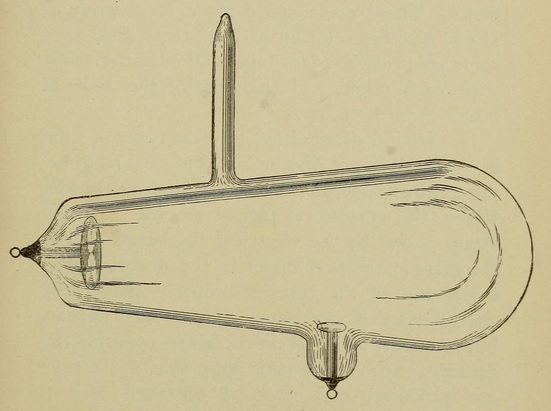
ON A NEW KIND OF RAYS
By W. C. RÖNTGEN
Sitzungsberichte der Würzburger Physikalischen-Medicinischen
Gesellschaft 1895, 132 (1895).
English translation by
George F. Barker, LL. D.,
in
Röntgen Rays: Memoirs by Röntgen,
Stokes and J. J. Thomson [New York: Harpers, 1899].
Röntgen's words are in bold.
1. If the discharge of a fairly large induction-coil be made to pass through a Hittorf vacuum-tube, or through a Lenard tube, a Crookes tube, or other similar apparatus, which has been sufficiently exhausted, the tube being covered with thin, black card-board which fits it with tolerable closeness, and if the whole apparatus be placed in a completely darkened room, there is observed at each discharge a bright illumination of a paper screen covered with barium platino-cyanide, placed in the vicinity of the induction-coil, the fluorescence thus produced being entirely independent of the fact whether the coated or the plain surface is turned towards the discharge-tube. This fluorescence is visible even when the paper screen is at a distance of two metres from the apparatus.
It is easy to prove that the cause of the fluorescence proceeds from the discharge-apparatus, and not from any other point in the conducting circuit.
2. The most striking feature of this phenomenon is the fact that an active agent here passes through a black card-board envelope, which is opaque to the visible and the ultra-violet rays of the sun or of the electric arc ; an agent, too, which has the power of producing active fluorescence. Hence we may first investigate the question whether other bodies also possess this property.
We soon discover that all bodies are transparent to this agent, though in very different degrees. (By "transparency" of a body I denote the relative brightness of a fluorescent screen placed close behind the body, referred to the brightness which the screen shows under the same circumstances, though without the interposition of the body.) I proceed to give a few examples :
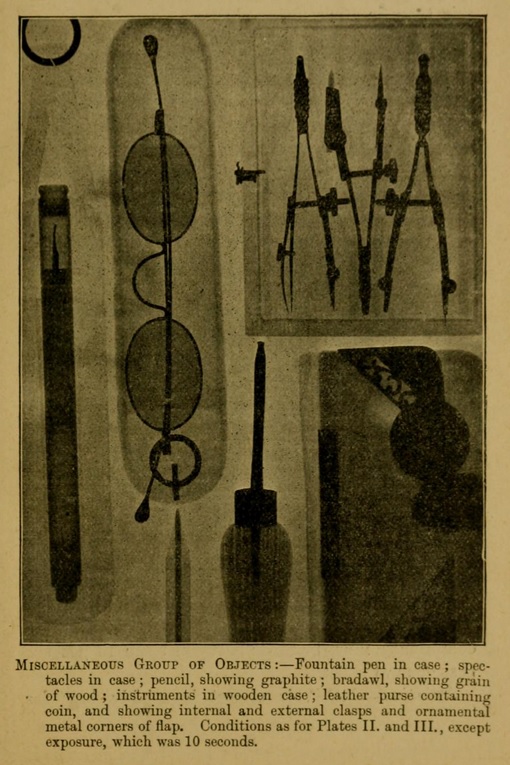
Illustration from X-Rays Simply Explained by R. P. Howgrave-Graham [London: Percival Marshall, 1903].
Paper is very transparent ; behind a bound book of about one thousand pages I saw the fluorescent screen light up brightly, the printers' ink offering scarcely a noticeable hinderance. In the same way the fluorescence appeared behind a double pack of cards ; a single card held between the apparatus and the screen being almost unnoticeable to the eye.
A single sheet of tin-foil is also scarcely perceptible ; it is only after several layers have been placed over one another that their shadow is distinctly seen on the screen.
Thick blocks of wood are also transparent, pine boards two or three centimetres thick absorbing only slightly.
A plate of aluminium about fifteen millimetres thick, though it enfeebled the action seriously, did not cause the fluorescence to disappear entirely.
Sheets of hard rubber several centimetres thick still permit the rays to pass through them. (For brevity's sake I shall use the expression "rays" ; and to distinguish them from others of this name I shall call them "X-rays.")
Glass plates of equal thickness behave quite differently, according as they contain lead (flint-glass) or not ; the former are much less transparent than the latter.
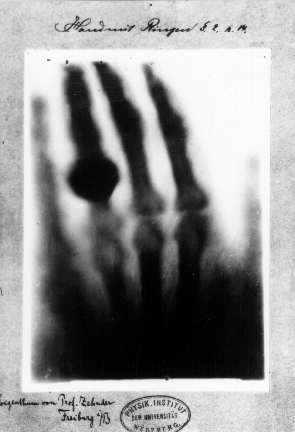
Röntgen's first photograph of his wife's left hand, with wedding ring.
If the hand be held between the discharge-tube and the screen, the darker shadow of the bones is seen within the slightly dark shadow-image of the hand itself.
Water, carbon disulphide, and various other liquids, when they are examined in mica vessels, seem also to be transparent. That hydrogen is to any considerable degree more transparent than air I have not been able to discover.
Behind plates of copper, silver, lead, gold, and platinum the fluorescence may still be recognized, though only if the thickness of the plates is not too great. Platinum of a thickness of 0.2 millimetre is still transparent ; the silver and copper plates may even be thicker. Lead of a thickness of 1.5 millimetres is practically opaque ; and on account of this property this metal is frequently most useful.
A rod of wood with a square cross -section (20 x 20 millimetres), one of whose sides is painted white with lead paint, behaves differently according as to how it is held between the apparatus and the screen. It is almost entirely without action when the X-rays pass through it parallel to the painted side ; whereas the stick throws a dark shadow when the rays are made to traverse it perpendicular to the painted side.
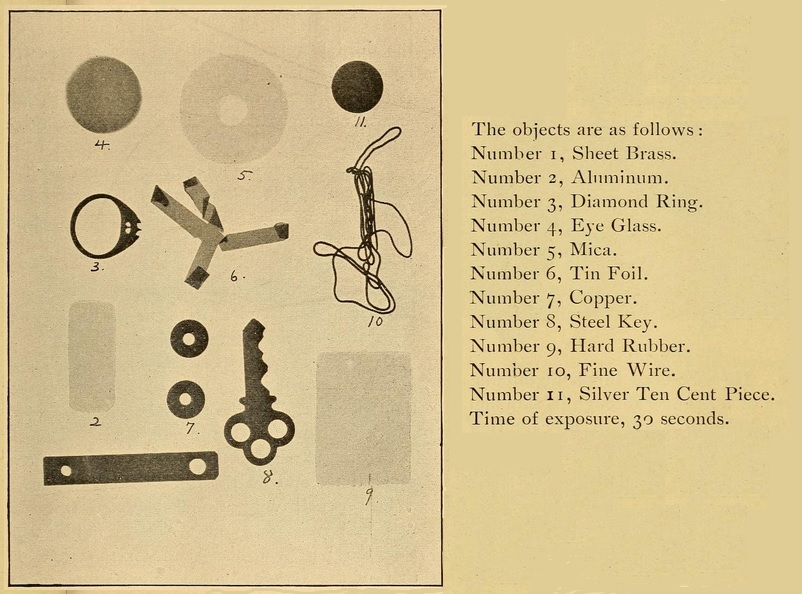
Various objects, most of which (except the aluminium, the mica, and the hard rubber) show little transparency. Illustration from Something About X Rays for Everybody by Edward Trevert [Lynn, Mass.: Bubier, 1896]. Books aimed at the home experimenter were already being published within a year of Röntgen's discovery.
In a series similar to that of the metals themselves their salts can be arranged with reference to their transparency, either in the solid form or in solution.
3. The experimental results which have now been given, as well as others, lead to the conclusion that the transparency of different substances, assumed to be of equal thickness, is essentially conditioned upon their density : no other property makes itself felt like this, certainly to so high a degree.
The following experiments show, however, that the density is not the only cause acting. I have examined, with reference to their transparency, plates of glass, aluminium, calcite, and quartz, of nearly the same thickness ; and while these substances are almost equal in density, yet it was quite evident that the calcite was sensibly less transparent than the other substances, which appeared almost exactly alike. No particularly strong fluorescence of calcite, especially by comparison with glass, has been noticed.
4. All substances with increase in thickness become less transparent. In order to find a possible relation between transparency and thickness, I have made photographs in which portions of the photographic plate were covered with layers of tin-foil, varying in the number of sheets superposed. Photometric measurements of these will be made when I am in possession of a suitable photometer.
5. Sheets of platinum, lead, zinc, and aluminium were rolled of such thickness that all appeared nearly equally transparent. The following table contains the absolute thickness of these sheets measured in millimetres, the relative thickness referred to that of the platinum sheet, and their densities :

We may conclude from these values that different metals possess transparencies which are by no means equal, even when the product of thickness and density are the same. The transparency increases much more rapidly than this product decreases.
6. The fluorescence of barium platino-cyanide is not the only recognizable effect of the X-rays. It should be mentioned that other bodies also fluoresce ; such, for instance, as the phosphorescent calcium compounds, then uranium glass, ordinary glass, calcite, rock-salt, and so on.
Of special significance in many respects is the fact that photographic dry plates are sensitive to the X-rays. We are, therefore, in a condition to determine more definitely many phenomena, and so the more easily to avoid deception ; wherever it has been possible, therefore, I have controlled, by means of photography, every important observation which I have made with the eye by means of the fluorescent screen.
In these experiments the property of the rays to pass almost unhindered through thin sheets of wood, paper, and tin-foil is most important. The photographic impressions can be obtained in a non-darkened room with the photographic plates either in the holders or wrapped up in paper. On the other hand, from this property it results as a consequence that undeveloped plates cannot be left for a long time in the neighborhood of the discharge-tube, if they are protected merely by the usual covering of pasteboard and paper.
It appears questionable, however, whether the chemical action on the silver salts of the photographic plates is directly caused by the X-rays. It is possible that this action proceeds from the fluorescent light which, as noted above, is produced in the glass plate itself or perhaps in the layer of gelatin. "Films" can be used just as well as glass plates.
I have not yet been able to prove experimentally that the X-rays are able also to produce a heating action; yet we may well assume that this effect is present, since the capability of the X-rays to be transformed is proved by means of the observed fluoresence phenomena. It is certain, therefore, that all the X-rays which fall upon a substance do not leave it again as such.
The retina of the eye is not sensitive to these rays. Even if the eye is brought close to the discharge-tube, it observes nothing, although, as experiment has proved, the media contained in the eye must be sufficiently transparent to transmit the rays.
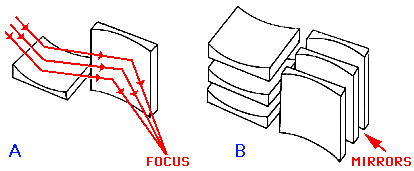
X-ray optics: a hard problem. In 1948 Kirkpatrick and Baez designed the first semi-practical X-ray telescope (with beryllium mirrors), based on the principle shown here, although such a device would not be built until 1975. The astronomical imaging system designed by Wolter in 1952 would be realised earlier (1963). X-ray microscopy would only emerge in the 1990s. [Graphic: Goddard Space Flight Center].
7. After I had recognized the transparency of various substances of relatively considerable thickness, I hastened to see how the X-rays behaved on passing through a prism, and to find whether they were thereby deviated or not.
Experiments with water and with carbon disulphide enclosed in mica prisms of about 30° refracting angle showed no deviation, either with the fluorescent screen or on the photographic plate. For purposes of comparison the deviation of rays of ordinary light under the same conditions was observed; and it was noted that in this case the deviated images fell on the plate about 10 or 20 millimetres distant from the direct image.
By means of prisms made of hard rubber and of aluminium, also of about 30° refracting angle, I have obtained images on the photographic plate in which some small deviation may perhaps be recognized. However, the fact is quite uncertain; the deviation, if it does exist, being so small that in any case the refractive index of the X-rays in the substances named cannot be more than 1.05 at the most. With a fluorescent screen I was also unable to observe any deviation.
Up to the present time experiments with prisms of denser metals have given no definite results, owing to their feeble transparency and the consequently diminished intensity of the transmitted rays.
With reference to the general conditions here involved on the one hand, and on the other to the importance of the question whether the X-rays can be refracted or not on passing from one medium into another, it is most fortunate that this subject may be investigated in still another way than with the aid of prisms. Finely divided bodies in sufficiently thick layers scatter the incident light and allow only a little of it to pass, owing to reflection and refraction ; so that if powders are as transparent to X-rays as the same substances are in mass -- equal amounts of material being presupposed -- it follows at once that neither refraction nor regular reflection takes place to any sensible degree.
Experiments were tried with finely powdered rock-salt, with fine electrolytic silver-powder, and with zinc-dust, such as is used in chemical investigations. In all these cases no difference was detected between the transparency of the powder and that of the substance in mass, either by observation with the fluorescent screen or with the photographic plate.
From what has now been said it is obvious that the X-rays cannot be concentrated by lenses, neither a large lens of hard rubber nor a glass lens having any influence upon them. The shadow-picture of a round rod is darker in the middle than at the edge ; while the image of a tube which is filled with a substance more transparent than its own material is lighter at the middle than at the edge.
8. The question as to the reflection of the X-rays may be regarded as settled, by the experiments mentioned in the preceding paragraph, in favor of the view that no noticeable regular reflection of the rays takes place from any of the substances examined. Other experiments, which I here omit, lead to the same conclusion.
One observation in this connection should, however, be mentioned, as at first sight it seems to prove the opposite. I exposed to the X-rays a photographic plate which was protected from the light by black paper, and the glass side of which was turned towards the discharge-tube giving the X-rays. The sensitive film was covered, for the most part, with polished plates of platinum, lead, zinc, and aluminium arranged in the form of a star. On the developed negative it was seen plainly that the darkening under the platinum, the lead, and particularly the zinc, was stronger than under the other plates, the aluminium having exerted no action at all. It appears, therefore, that these three metals reflect the rays. Since, however, other explanations of the stronger darkening are conceivable, in a second experiment, in order to be sure, I placed between the sensitive film and the metal plates a piece of thin aluminium-foil, which is opaque to ultra-violet rays, but is very transparent to the X-rays. Since the same result substantially was again obtained, the reflection of X-rays from the metals above named is proved.
If we compare this fact with the observation already mentioned that powders are as transparent as coherent masses, and with the further fact that bodies with rough surfaces behave like polished bodies with reference to the passage of the X-rays, as shown also in the last experiment, we are led to the conclusion already stated that regular reflection does not take place, but that bodies behave towards the X-rays as turbid media do towards light.
Since, moreover, I could detect no evidence of refraction of these rays in passing from one medium into another, it would seem that X-rays move with the same velocity in all substances ; and, further, that this speed is the same in the medium which is present everywhere in space and in which the particles of matter are imbedded. These particles hinder the propagation of the X-rays, the effect being greater, in general, the more dense the substance concerned.
9. Accordingly it might be possible that the arrangement of particles in the substance exercised an influence on its transparency; that, for instance, a piece of calcite might be transparent in different degrees for the same thickness, according as it is traversed in the direction of the axis, or at right angles to it. Experiments, however, on calcite and quartz gave a negative result.
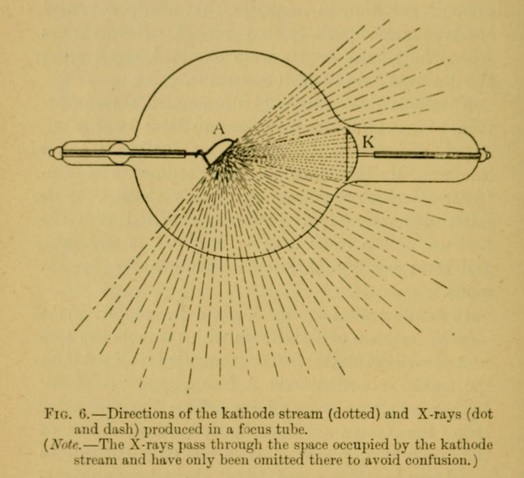
Comparison of X-ray and cathode-ray emission. Illustration from X-Rays Simply Explained by R. P. Howgrave-Graham [London: Percival Marshall, 1903].
10. It is well known that Lenard came to the conclusion, from the results of his beautiful experiments on the transmission of the cathode rays of Hittorf through a thin sheet of aluminium, that these rays are phenomena of the ether, and that they diffuse themselves through all bodies. We can say the same of our rays.
In his most recent research, Lenard has determined the absorptive power of different substances for the cathode rays, and, among others, has measured it for air from atmospheric pressure to 4.10, 3.40, 3.10, referred to 1 centimetre, according to the rarefaction of the gas contained in the discharge-apparatus. Judging from the discharge-pressure as estimated from the sparking distance, I have had to do in my experiments for the most part with rarefactions of the same order of magnitude, and only rarely with less or greater ones.
I have succeeded in comparing by means of the L. Weber photometer -- I do not possess a better one -- the intensities, taken in atmospheric air, of the fluorescence of my screen at two distances from the discharge-apparatus -- about 100 and 200 millimetres; and I have found from three experiments, which agree very well with each other, that the intensities vary inversely as the squares of the distances of the screen from the discharge-apparatus.
Accordingly, air absorbs a far smaller fraction of the X-rays than of the cathode rays. This result is in entire agreement with the observation mentioned above, that it is still possible to detect the fluorescent light at a distance of 2 metres from the discharge-apparatus.
Other substances behave in general like air; they are more transparent to X-rays than to cathode rays.

Deflection of cathode rays by a magnet. From Wm. Crookes's lecture On Radiant Matter [Sheffield, 1879]
11. A further difference, and a most important one, between the behavior of cathode rays and of X-rays lies in the fact that I have not succeeded, in spite of many attempts, in obtaining a deflection of the X-rays by a magnet, even in very intense fields.
The possibility of deflection by a magnet has, up to the present time, served as a characteristic property of the cathode rays ; although it was observed by Hertz and Lenard that there are different sorts of cathode rays, "which are distinguished from each other by their production of phosphoresceuce, by the amount of their absorption, and by the extent of their deflection by a magnet." A considerable deflection, however, was noted in all of the cases investigated by them ; so that I do not think that this characteristic will be given up except for stringent reasons.
12. According to experiments especially designed to test the question, it is certain that the spot on the wall of the discharge-tube which fluoresces the strongest is to be considered as the main centre from which the X-rays radiate in all directions. The X-rays proceed from that spot where, according to the data obtained by different investigators, the cathode rays strike the glass wall. If the cathode rays within the discharge-apparatus are deflected by means of a magnet, it is observed that the X-rays proceed from another spot --- namely, from that which is the new terminus of the cathode rays.
For this reason, therefore, the X-rays, which it is impossible to deflect, cannot be cathode rays simply transmitted or reflected without change by the glass wall. The greater density of the gas outside of the discharge-tube certainly cannot account for the great difference in the deflection, according to Lenard.
I therefore reach the conclusion that the X-rays are not identical with the cathode rays, but that they are produced by the cathode rays at the glass wall of the discharge-apparatus.
13. This production does not take place in glass alone, but, as I have been able to observe in an apparatus closed by a plate of aluminium 2 millimetres thick, in this metal also. Other substances are to be examined later.
14. The justification for calling by the name "rays" the agent which proceeds from the wall of the discharge-apparatus I derive in part from the entirely regular formation of shadows, which are seen when more or less transparent bodies are brought between the apparatus and the fluorescent screen (or the photographic plate).

The left hand of the anatomist Albert von Kölliker, photographed by Röntgen in 1896.
I have observed, and in part photographed, many shadow-pictures of this kind, the production of which has a particular charm. I possess, for instance, photographs of the shadow of the profile of a door which separates the rooms in which, on one side, the discharge-apparatus was placed, on the other the photographic plate ; the shadow of the bones of the hand ; the shadow of a covered wire wrapped on a wooden spool ; of a set of weights enclosed in a box ; of a galvanometer in which the magnetic needle is entirely enclosed by metal; of a piece of metal whose lack of homogeneity becomes noticeable by means of the X-rays, etc.
Another conclusive proof of the rectilinear propagation of the X-rays is a pin-hole photograph which I was able to make of the discharge-apparatus while it was enveloped in black paper; the picture. is weak but unmistakably correct.
15. I have tried in many ways to detect interference phenomena of the X-rays ; but, unfortunately, without success, perhaps only because of their feeble intensity.
16. Experiments have been begun, but are not yet finished, to ascertain whether electrostatic forces affect the X-rays in any way.
17. In considering the question what are the X-rays -- which, as we have seen, cannot be cathode rays -- we may perhaps at first be led to think of them as ultra-violet light, owing to their active fluorescence and their chemical actions. But in so doing we find ourselves opposed by the most weighty considerations.
If the X-rays are ultra-violet light, this light must have the following properties:
- On passing from air into water, carbon disulphide,
aluminium, rock-salt, glass, zinc, etc., it suffers no noticeable refraction.
- By none of the bodies named can it be regularly reflected
to any appreciable extent.
- It cannot be polarized by any of the ordinary methods.
- Its absorption is influenced by no other property of substances so much as by their density.
That is to say, we must assume that these ultra-violet rays behave entirely differently from the ultra-red [i.e. infra-red], visible, and ultra-violet rays which have been known up to this time. I have been unable to come to this conclusion, and so have sought for another explanation.


Transverse and longitudinal plane-waves. [Animation by Christophe Dang Ngoc Chan].
There seems to exist some kind of relationship between the new rays and light rays ; at least this is indicated by the formation of shadows, the fluorescence and the chemical action produced by them both. Now, we have known for a long time that there can be in the ether longitudinal vibrations besides the transverse light-vibrations ; and, according to the views of different physicists, these vibrations must exist. Their existence, it is true, has not been proved up to the present, and consequently their properties have not been investigated by experiment.
Ought not, therefore, the new rays to be ascribed to longitudinal vibrations in the ether ?
I must confess that in the course of the investigation I have become more and more confident of the correctness of this idea, and so, therefore, permit myself to announce this conjecture, although I am perfectly aware that the explanation given still needs further confirmation.
WÜRZBURG,
Physikalisches Institut der Universität.
December, 1895.
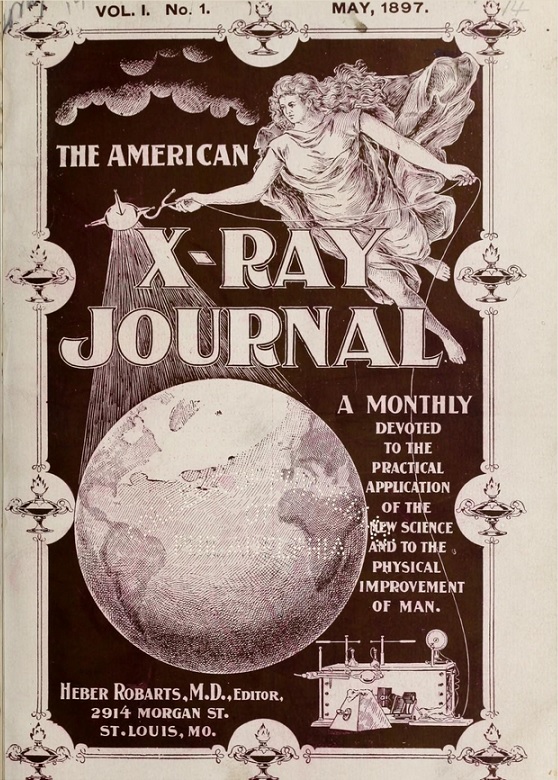
Only a year and a half later!